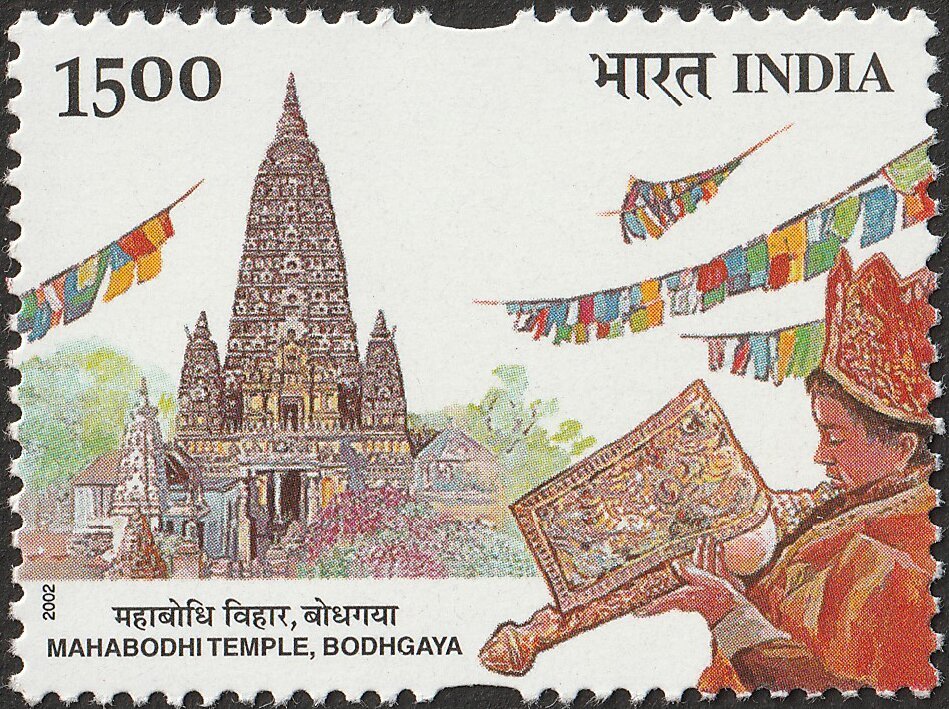Mahabodhi Temple, Bodhgaya

Technical Data
| Stamp Set | Bauddha Mahotsav Festival |
|---|---|
| Date of Issue | January 22, 2002 |
| Denomination | Rs. 15 |
| Quantity | 1,500,000 |
| Perforation | Syncopated 13½ x 13 |
| Printer | Calcutta Security Printers Ltd |
| Watermark | No Watermark |
| Colors | Multicolor |
| Catalog Codes |
Michel IN 1894 Stamp Number IN 1947 Yvert et Tellier IN 1659 Stanley Gibbons IN 2059 WADP Numbering System - WNS IN006.02 |
| Themes | Festivals | Religion | Temples | UNESCO World Heritage Sites |
Table of Contents
Commemorative Stamp Set: Mahabodhi Temple, Bodhgaya
Design Elements:
The stamp highlighting the Mahabodhi Temple would center around the iconic spire of the temple, symbolizing the site of Buddha’s enlightenment. The intricate architecture of the temple, with its grand stupa and geometric carvings, would be detailed in the design. A representation of the Bodhi tree, under which Buddha meditated and attained enlightenment, could also be included, either in the background or as a prominent feature. The use of soft golden and green hues would evoke the serenity and sacredness of the temple complex.
Cultural and Historical Significance:
The Mahabodhi Temple in Bodhgaya is one of the most important and revered Buddhist pilgrimage sites in the world, as it marks the exact location where Prince Siddhartha Gautama attained enlightenment and became the Buddha. This site has been a center of Buddhist worship and devotion for over two millennia and is a UNESCO World Heritage site. It represents the teachings of Buddhism, emphasizing mindfulness, wisdom, and the cessation of suffering. The temple’s architecture is a blend of ancient Indian styles and Buddhist symbolism, making it a significant historical and cultural monument.
Usage:
This stamp would be particularly meaningful for promoting religious tourism and cultural exchange programs centered on India’s Buddhist heritage. It could also be used in government communications related to heritage conservation, spiritual events, and international cultural diplomacy. For philatelists, it offers an important addition to collections focused on world heritage sites or religious landmarks. Additionally, it could be issued during festivals like Buddha Purnima to commemorate Lord Buddha’s life and teachings.
Importance of the Commemorative Stamp Set:
By including the Mahabodhi Temple in this commemorative stamp set, the Department of Posts honors India’s significant contribution to the global Buddhist community and the spiritual journey of millions of pilgrims who visit the temple annually. The stamp reinforces India’s reputation as the birthplace of Buddhism and a key destination for spiritual seekers. It also highlights the importance of preserving ancient religious monuments that hold historical, cultural, and spiritual value.
Example of the Stamp Design:
The stamp design could feature the towering central stupa of the Mahabodhi Temple with the Bodhi tree in the foreground. Golden and earthy tones would be used to highlight the temple’s sacredness, while small figures of monks or devotees in prayer could be depicted near the base of the temple to illustrate its spiritual significance. The design would evoke reverence and the peaceful pursuit of enlightenment.
The commemorative stamp set might include:
- Mahabodhi Temple, Bodhgaya – The place of Buddha’s enlightenment.
- Mahaparinirvana Temple, Kushinagar – The site where Buddha attained Mahaparinirvana.
- Dhamek Stupa, Sarnath – The location of Buddha’s first sermon.
- Gridhakuta Hills, Rajgir – The site of many important teachings by Buddha.
Significance:
The Mahabodhi Temple stamp stands as a symbol of spiritual awakening and the birthplace of Buddhism’s core teachings. This stamp, along with the others in the set, celebrates the journey of Buddha and the spread of his teachings across the world. The set as a whole serves to strengthen the cultural and religious connection between India and the global Buddhist community, highlighting the country’s rich historical and spiritual legacy.
